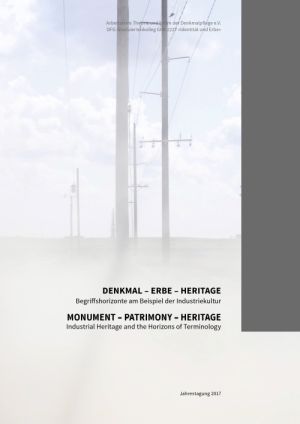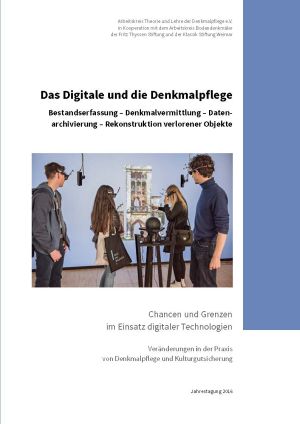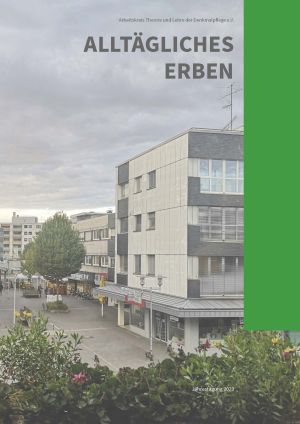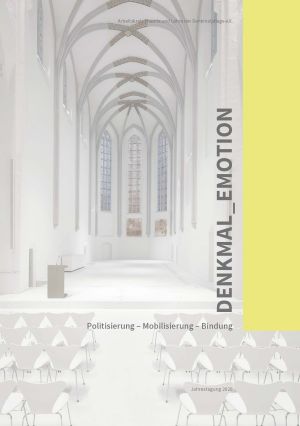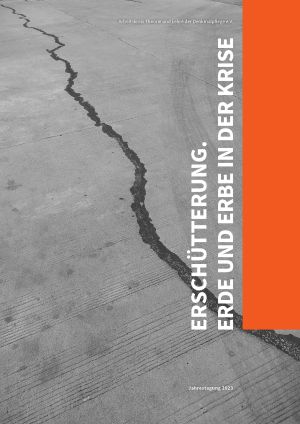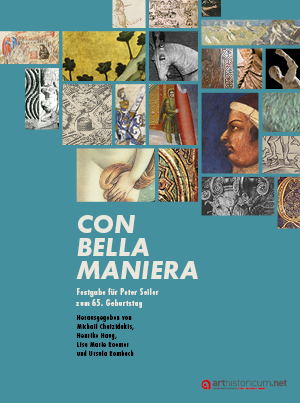Meier, Hans-Rudolf
Kulturreformer. Rassenideologe. Hochschuldirektor: Der lange Schatten des Paul Schultze-Naumburg
Paul Schultze-Naumburg (1869–1949), Mitbegründer des Werkbundes und des Deutschen Bundes Heimatschutz, gehört zu den schillerndsten Vertretern der deutschen Kulturgeschichte des frühen 20. Jahrhunderts. Als Maler, Publizist, Unternehmer, Architekt und Kulturpolitiker erreichte er eine große Popularität, nach dem Ersten Weltkrieg radikalisierte er sich jedoch zum völkischen Rassisten und wurde früh Mitglied der NSDAP.
Von 1930 bis 1940 leitete Paul Schultze-Naumburg die „Staatlichen Hochschulen für Baukunst, bildende Künste und Handwerk“ in Weimar. Der Zielvorgabe folgend, die ehemalige Bauhaus-Stätte auf den Kurs der neuen Machthaber zu bringen, entwickelte Schultze-Naumburg ein explizit antimodernes, an Heimatschutz orientierter Handwerklichkeit ausgerichtetes Konzept.
Im vorliegenden Band werden Persönlichkeit, Werk und Wirken Paul Schultze-Naumburgs sowie das Profil der Weimarer Hochschule unter seinem Direktorat beleuchtet. Nicht zuletzt werden Wirkung und Nachleben dieser widersprüchlichen, bis heute schwierigen und daher wenig beforschten Persönlichkeit diskutiert. Vorgelegt werden die Ergebnisse eines vom Bauhaus-Institut für Geschichte und Theorie der Architektur und Planung organisierten wissenschaftlichen Symposiums, das vom 3. bis 4. Dezember 2015 an der Bauhaus-Universität Weimar stattfand.
Denkmal – Erbe – Heritage: Begriffshorizonte am Beispiel der Industriekultur
Dieser Band ist zweisprachig (dt./eng.)
Der Band „Denkmal – Erbe – Heritage“ umfasst unterschiedliche disziplinäre und generationsspezifische Ansätze zu den Titel gebenden Begriffen, die mit dem Motto „Sharing Heritage“ des Kulturerbejahres 2018 korrespondieren. Entstanden ist der Band 2017 aus der Kooperation des Arbeitskreises Theorie und Lehre der Denkmalpflege e.V. mit dem Graduiertenkolleg 2227 „Identität und Erbe“, die ihre Jahrestagung zusammenlegten.
Wenn „Sharing Heritage“ ernst gemeint ist, muss das auch Konsequenzen für die Bewertung von Objekten haben – auch über Europa hinaus: anstelle des eher exkludierenden „World Heritage“, das zumeist die eigenen, oft national definierten Verdienste in den Vordergrund rückt, wäre ein kritisches „Global Heritage“ anzustreben, das auf der Grundlage universeller Werte die notwendigen Brücken bauen kann, um die Menschen als globale Schicksalsgemeinschaft einander näher zu bringen.
Mimetische Praktiken in der neueren Architektur: Prozesse und Formen der Ähnlichkeitserzeugung
Praktiken des Zitierens, Kopierens, der Montage, des Rekonstruierens, der Analogiebildung und der Mimikry sind gängige Verfahren im architektonischen Alltag. Dennoch ist das Paradigma der Originalität bis heute beherrschend und verstellt oft den Blick auf mimetische Phänomene. Der Tagungsband versammelt zwölf im Jahr 2016 auf der Konferenz „Ähnlichkeit: Prozesse und Formen“ in der Bibliothek der Stiftung Werner Oechslin in Einsiedeln gehaltene Vorträge, ergänzt durch zwei Artikel der Herausgeberinnen. Der Fokus der Tagung lag auf aktuellen Forschungen zu Praktiken der Ähnlichkeitserzeugung in der neueren Architektur und wurde von Teilprojekten der DFG-SNF-Forschergruppe „Medien und Mimesis“ organisiert.
Das Digitale und die Denkmalpflege: Bestandserfassung – Denkmalvermittlung – Datenarchivierung – Rekonstruktion verlorener Objekte
Die „digitale Revolution“ ist längst in vollem Gange. Für die Denkmalpflege haben digitale Anwendungen neue Perspektiven geöffnet, etwa in der interaktiven Visualisierung verlorener Zustände, im Monitoring bedrohter Stätten und Artefakte oder in der komplexen Vernetzung heterogener Wissensbestände. Deutlicher werden inzwischen auch Grenzen und ungelöste Probleme im Einsatz digitaler Technologien, etwa was die Nachhaltigkeit der rapide wachsenden Datenmengen betrifft.
Doch haben wir es in Bezug auf die Digitalisierung nicht in erster Linie mit einer nur „technischen“ Neuerung zu tun. So wird das Bemühen um das digitale Erbe, mit dem Auftrag zur Dokumentation, Erforschung und Publizierung von Kulturgütern, nicht nur die Institution Museum transformieren. Zu beobachten ist auch, dass sich mit der neuen Fülle an digital erzeugten Bildern die wissenschaftlichen Standards verändern. Ein weiterer unterschätzter Aspekt der digitalen Revolution ist eine Umschichtung der Aufmerksamkeiten auf dem „Markt“ der Wissenschaften.
Die wohl auffälligste Folge des digitalen Versprechens einer genauen und verlustfreien Reproduktion des Verlorenen ist, dass bei jeder spektakulären Zerstörung von bekannten Monumenten reflexhaft die Forderung nach einer Rekonstruktion aufkommt. Deutlich wird hier, dass dem Digitalen eine innere Affinität zur Rekonstruktion innewohnt, insofern seine Leistungsfähigkeit in der Übersetzung aller Informationen in einen binären Code, in der angeblich verlustfreien Speicherung und Kopie beruht. Im digitalen Zeitalter wird die Unterscheidung von Original und Kopie so an Relevanz verlieren – auch zu dem Preis einer totalen Manipulierbarkeit der Daten, wie der Realität.
Alltägliches Erben
Beim Blick auf das „historisch wertvolle Stadtbild“, auf Denkmäler und bauliches Erbe bleibt ein Großteil des alltäglichen Baubestandes außen vor, auch wenn dieser unsere bauliche Umgebung prägt und etwa geschichtliche oder städtebauliche Bedeutungen haben kann: Oft scheint es, als schafften es nur „die Highlights“ in den kunsthistorischen und denkmalwissenschaftlichen Kanon. Der Tagungsband ALLTÄGLICHES ERBEN behandelt daher grundsätzliche Fragen nach Wahrnehmung, Wertschätzung und Denkmalwürdigkeit alltäglicher Architektur. In unterschiedlichen Perspektiven werden internationale, historische und theoretische Hintergründe des Alltäglichen beleuchtet, konkrete Bauaufgaben alltäglicher Architekturen besprochen sowie der Blick auf die Herausforderungen der denkmalpflegerischen Praxis von Inventarisation und Unterschutzstellung gerichtet.
Denkmal_Emotion: Politisierung – Mobilisierung – Bindung
In Bezug auf das Kulturerbe sind die Emotionen als Thema zurück; der „emotional turn“, so scheint es, hat die Denkmalwissenschaften erreicht. Die Verbindung zwischen Emotionen und Erbe/Denkmal ist dabei als eine wechselseitige und voneinander abhängige Beziehung zu denken. Verstanden als integraler Bestandteil von Prozessen individueller und kollektiver Sinnstiftung, werden Emotionen vom Nebenprodukt zu einem prägenden Aspekt von Inwertsetzungen, Aneignungen und Ablehnungen, wie sie für das Feld der Denkmalpflege konstituierend sind. Die hier versammelten Beiträge spiegeln in ihrer Bandbreite die unterschiedlichen Facetten des komplexen Verhältnisses zwischen Denkmalwissenschaften und Emotionen wider, sei es in Bezug auf seine politischen Dimensionen, auf die Entwicklung neuer emotionaler Bezugspunkte oder auf ganz konkrete Prozesse von Denkmalaneignung oder -ablehnung.
Erschütterung. Erde und Erbe in der Krise: Tremor. Earth and Heritage in Crisis
Erschütterung spannt bewusst einen Bogen von der Zerstörung und Beschädigung von Baudenkmälern, bedingt durch physische Krisen wie Erdbeben, Flut oder Krieg, hin zu den emotionalen wie sozialen und gesellschaftlichen Erschütterungen, die in diesem Kontext entstehen. Der Untertitel Erde und Erbe in der Krise verweist dabei auf die enge Verflechtung zwischen globalen Katastrophen, Heritage Making und Denkmalschutz. Der Tagungsband behandelt daher grundsätzliche Fragen nach dem denkmalpflegerischen Umgang mit solchen Krisen und ihren Folgen. Neben Themen des Konservierens und Restaurierens, Strategien des Wiederaufbauens und Erinnerns, wird danach gefragt, wie die Disziplin der Denkmalpflege selbst durch Krisen geformt wurde. Anhand interdisziplinärer Fallbeispiele wird erörtert, welche Grenzen, Möglichkeiten und Konflikte des Erbens durch Krieg und Trauma entstehen.
Con bella maniera: Festgabe für Peter Seiler zum 65. Geburtstag
Con bella maniera... unter diesem Titel ehren die Autor:innen des vorliegenden Bandes den Kunsthistoriker Peter Seiler. Ihre Beiträge spiegeln nicht nur das gattungs- und epochenübergreifende Forschungsinteresse und den interdisziplinären Zugang des Jubilars, sondern bezeugen Freundschaften, die sich aus allen Phasen seiner wissenschaftlichen Vita erhalten haben – von den studentischen Anfängen in Heidelberg über die prägende Zeit als Stipendiat in Rom an der Bibliotheca Hertziana bis zu seinem Wirken an den kunstgeschichtlichen Instituten der Freien Universität und der Humboldt-Universität zu Berlin als wissenschaftlicher Mitarbeiter, Privatdozent, Leiter des Census und außerplanmäßiger Professor. Seine bella maniera geht über den kunsthistorischen terminus technicus hinaus und verbindet „altehrwürdige erlernbare Praktiken“ der Kunstgeschichte, innovative Forschungsansätze und die feine Art des menschlichen Umgangs.




